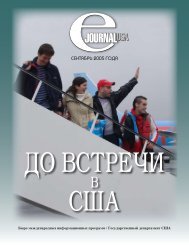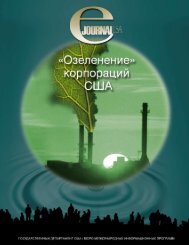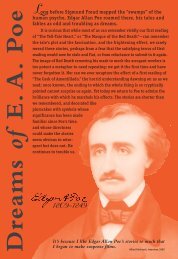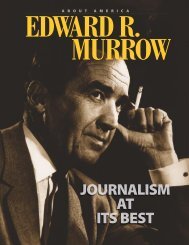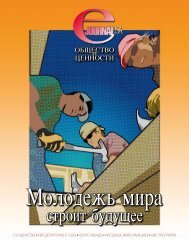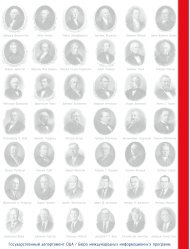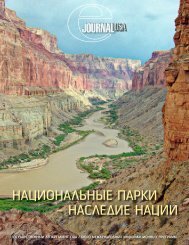AMERICAN
Outline of American Literature
Outline of American Literature
- No tags were found...
Create successful ePaper yourself
Turn your PDF publications into a flip-book with our unique Google optimized e-Paper software.
to be identical with the world — a<br />
microcosm of the world itself. The<br />
doctrine of self-reliance and individualism<br />
developed through the<br />
belief in the identification of the<br />
individual soul with God.<br />
Transcendentalism was intimately<br />
connected with Concord, a small<br />
New England village 32 kilometers<br />
west of Boston. Concord was the<br />
first inland settlement of the original<br />
Massachusetts Bay Colony.<br />
Surrounded by forest, it was and<br />
remains a peaceful town close<br />
enough to Boston’s lectures, bookstores,<br />
and colleges to be intensely<br />
cultivated, but far enough away to<br />
be serene. Concord was the site<br />
of the first battle of the American<br />
Revolution, and Ralph Waldo<br />
Emerson’s poem commemorating<br />
the battle, “Concord Hymn,” has<br />
one of the most famous opening<br />
stanzas in American literature:<br />
By the rude bridge that arched<br />
the flood<br />
Their flag to April’s breeze<br />
unfurled,<br />
Here once the embattled farmers<br />
stood<br />
And fired the shot heard round<br />
the world.<br />
RALPH<br />
WALDO EMERSON<br />
Photo courtesy<br />
National Portrait Gallery,<br />
Smithsonian Institution<br />
Concord was the first rural artist’s<br />
colony, and the first place to<br />
offer a spiritual and cultural alternative<br />
to American materialism. It<br />
was a place of high-minded conversation<br />
and simple living (Emerson<br />
and Henry David Thoreau both had<br />
vegetable gardens). Emerson, who<br />
moved to Concord in 1834, and<br />
Thoreau are most closely associated<br />
with the town, but the locale also<br />
attracted the novelist Nathaniel<br />
Hawthorne, the feminist writer<br />
Margaret Fuller, the educator (and<br />
father of novelist Louisa May Alcott)<br />
Bronson Alcott, and the poet<br />
William Ellery Channing. The Transcendental<br />
Club was loosely organized<br />
in 1836 and included, at various<br />
times, Emerson, Thoreau,<br />
Fuller, Channing, Bronson Alcott,<br />
Orestes Brownson (a leading minister),<br />
Theodore Parker (abolitionist<br />
and minister), and others.<br />
The Transcendentalists published<br />
a quarterly magazine, The Dial,<br />
which lasted four years and was<br />
first edited by Margaret Fuller and<br />
later by Emerson. Reform efforts<br />
engaged them as well as literature.<br />
A number of Transcendentalists<br />
were abolitionists, and some were<br />
involved in experimental utopian<br />
communities such as nearby Brook<br />
Farm (described in Hawthorne’s<br />
The Blithedale Romance) and<br />
Fruitlands.<br />
Unlike many European groups,<br />
the Transcendentalists never issued<br />
a manifesto. They insisted on<br />
individual differences — on the<br />
unique viewpoint of the individual.<br />
American Transcendental Romantics<br />
pushed radical individualism to the<br />
extreme. American writers often<br />
saw themselves as lonely explorers<br />
outside society and convention.<br />
The American hero — like Herman<br />
Melville’s Captain Ahab, or Mark<br />
Twain’s Huck Finn, or Edgar Allan<br />
Poe’s Arthur Gordon Pym — typically<br />
faced risk, or even certain<br />
destruction, in the pursuit of meta-<br />
27




